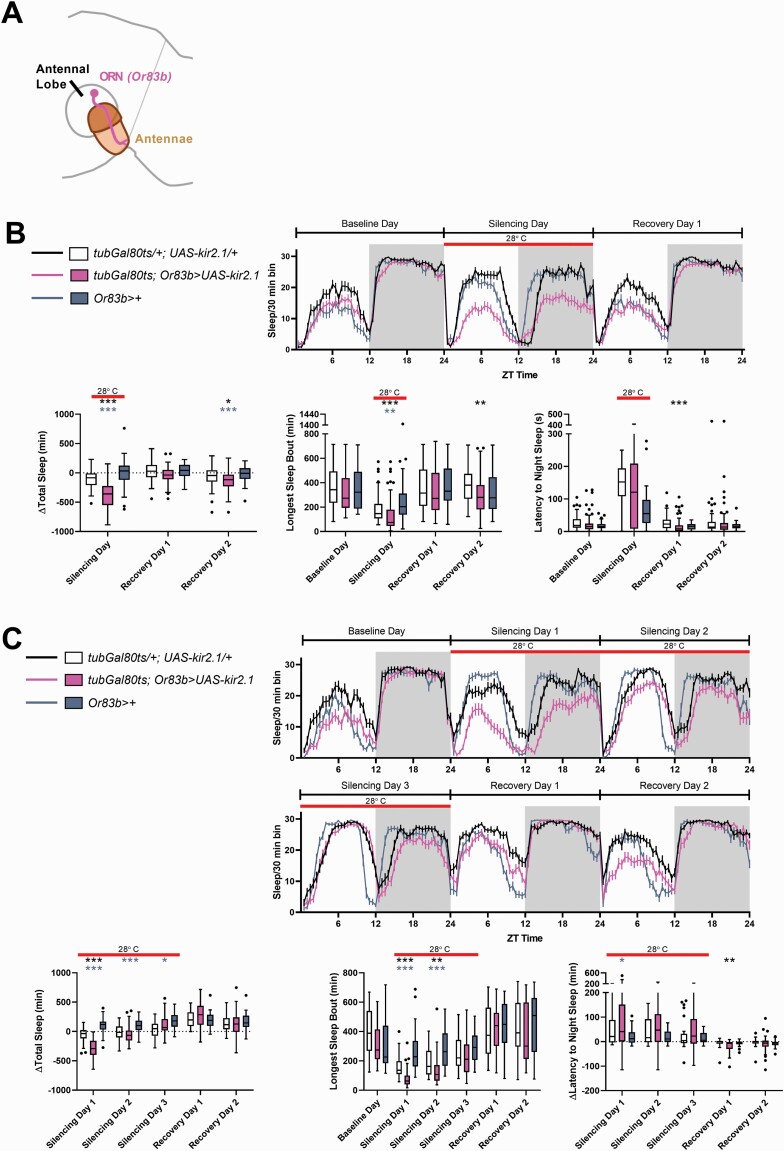Figure 2.
Silencing ORNs also decreases sleep. (A) Schematic illustrating the first order olfactory sensory neurons (ORNs) carrying information from the antennae to fly’s brain via the antennae lobe. ORNs are labeled using Or83b-Gal4. (B) Top panel shows the amount of sleep during the baseline, silencing, and recovery days in 30 min bins over the 24 h day. The red bar (in all panels) indicates the time period during which the temperature was raised to 28°C, thereby inactivating the GAL80 repressor and silencing the Or83b+ neurons. Flies with ORNs silenced have reduced sleep (bottom left) and decreased bout length (bottom middle). Change in sleep relative to baseline was plotted because of significant differences between the three genotypes at baseline (at the permissive temperature) (Supplementary Figure S2B). *p < 0.05, **p < 0.01, ***p < 0.001 by Kruskal–Wallis test with Dunn’s multiple comparison test between the experimental genotype (tubGal80ts; Or83b>UAS-kir2.1) and each of the controls. Black asterisks indicate significant comparisons between control flies of the genotype tubGal80ts/+; UAS-kir2.1/+ (n = 45) and experimental flies of the genotype tubGal80ts; Or83b>UAS-kir2.1 (n = 61). Blue-grey asterisks indicate significant differences between control flies of the genotype Or83b>+ (n = 45) and experimental flies of the genotype tubGal80ts; Or83b>UAS-kir2.1. (C) Extending the time at the restrictive temperature did not increase the magnitude of sleep loss; instead, experimental flies (tubGal80ts; Or83b>UAS-kir2.1, pink, n = 37) only showed significant differences relative to both genetic controls on the first day of silencing (bottom left). Change in sleep relative to baseline was plotted because of significant differences between the three genotypes at baseline (at the permissive temperature, see Supplementary Figure S2C). Black asterisks indicate significant comparisons between control flies of the genotype tubGal80ts/+; UAS-kir2.1/+ (n = 33) and experimental flies of the genotype tubGal80ts; Or83b>UAS-kir2.1. Blue–gray asterisks indicate significant differences between control flies of the genotype Or83b>+ (n = 34) and experimental flies of the genotype tubGal80ts; Or83b>UAS-kir2.1.

